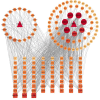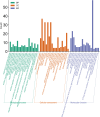Exploring the molecular mechanism of Mahuang decoction against influenza: An integrated computational and experimental study
- PMID: 40725914
- PMCID: PMC12303530
- DOI: 10.1097/MD.0000000000043439
Exploring the molecular mechanism of Mahuang decoction against influenza: An integrated computational and experimental study
Abstract
Background: Mahuang Decoction (MHD) is primarily used to treat viral colds and alleviate muscle pain, with extensive clinical application. However, its therapeutic effects against influenza and its anti-inflammatory mechanisms remain unclear.
Methods: Active compounds and targets were identified using the Traditional Chinese Medicine Systems Pharmacology Database platform, OMIM database, and GeneCards database. Protein-protein interaction networks and compound-target networks were constructed to screen core targets and components. Gene Ontology and Kyoto Encyclopedia of Genes and Genomes enrichment analyses were performed using the DAVID database, and the results were visualized via the Microbioinformatics platform. Molecular docking was employed to evaluate the binding affinity between potential targets and active compounds. Finally, cytopathic effect assays and reverse transcription polymerase chain reaction experiments were conducted for validation.
Results: Network pharmacology studies revealed that AKT1, EGFR, and SRC are core targets of MHD in treating influenza, with kaempferol, quercetin, and luteolin as key compounds. The mechanism of MHD is closely associated with antiviral, anti-inflammatory, and immune-regulatory effects. Cytopathic effect assays and reverse transcription polymerase chain reaction experiments confirmed the therapeutic effects of key compounds against H1N1.
Conclusion: This study demonstrates that MHD exhibits anti-H1N1 viral activity and comprehensively elucidates its active components, potential targets, and molecular mechanisms in influenza treatment. These findings provide a theoretical foundation for further exploration of MHD's protective effects and anti-inflammatory mechanisms against influenza.
Keywords: Mahuang decoction; RT-PCR; cell experiments; influenza; molecular docking; network pharmacology.
Copyright © 2025 the Author(s). Published by Wolters Kluwer Health, Inc.
Conflict of interest statement
The authors have no funding and conflicts of interest to disclose.
Figures










Similar articles
-
Elucidating the Mechanism of Xiaoqinglong Decoction in Chronic Urticaria Treatment: An Integrated Approach of Network Pharmacology, Bioinformatics Analysis, Molecular Docking, and Molecular Dynamics Simulations.Curr Comput Aided Drug Des. 2025 Jul 16. doi: 10.2174/0115734099391401250701045509. Online ahead of print. Curr Comput Aided Drug Des. 2025. PMID: 40676786
-
Elucidation of the mechanism of treating endometriosis with Ge Xia-Zhu Yu decoction by means of network pharmacology and molecular docking.Medicine (Baltimore). 2025 Jul 25;104(30):e43115. doi: 10.1097/MD.0000000000043115. Medicine (Baltimore). 2025. PMID: 40725959 Free PMC article.
-
Multi-target Mechanisms of Si-Ni-San on Anxious Insomnia: An Example of Network-pharmacology and Molecular Docking Analysis.Curr Med Chem. 2025;32(13):2640-2663. doi: 10.2174/0109298673299665240924090617. Curr Med Chem. 2025. PMID: 39410900 Free PMC article.
-
Exploring the mechanism of ShenGui capsule in treating heart failure based on network pharmacology and molecular docking: A review.Medicine (Baltimore). 2024 Apr 5;103(14):e37512. doi: 10.1097/MD.0000000000037512. Medicine (Baltimore). 2024. PMID: 38579077 Free PMC article. Review.
-
Medicine for chronic atrophic gastritis: a systematic review, meta- and network pharmacology analysis.Ann Med. 2023;55(2):2299352. doi: 10.1080/07853890.2023.2299352. Epub 2024 Jan 3. Ann Med. 2023. PMID: 38170849 Free PMC article.
References
-
- Gaitonde DY, Moore FC, Morgan MK. Influenza: diagnosis and treatment. Am Fam Physician. 2019;100:751–8. - PubMed
MeSH terms
Substances
LinkOut - more resources
Full Text Sources
Medical
Research Materials
Miscellaneous

